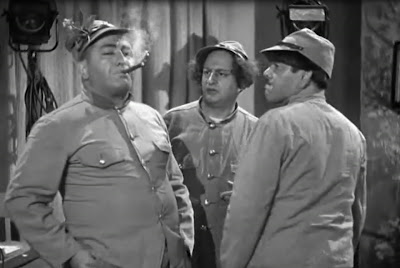It amazes me that I can go on YouTube every few months and find rare silent film comedies. My latest YouTube search turned up five interesting films.
1.) The Lyin' Tamer (1926)
The "lion comedy" is well represented by this 1926 Fox Imperial comedy. Michael Rogge, who posted The Lyin' Tamer on YouTube, admitted that he did not recognize the star of the film. One commenter thought it was Raymond Griffith, which is reasonable as the actor does bear a passing resemblance to Griffith. But the actor is, in fact, Ernie Shields. Shields may be a mysterious figure today, but he became a familiar face to film fans of his day after starring in nearly eighty Universal comedies from 1914 to 1919.
The Lyin' Tamer is effective even though it is hardly original. The following routine from the film falls squarely into the conventional category.
Abbott & Costello still had use for the routine more than twenty years later when they made the jungle comedy Africa Screams (1949).
Here we have yet another routine that The Lyin' Tamer borrowed.
The tilting house routine that appears in the final clip was another well-worn bit of business. The routine was discussed previously on this blog. But at least the filmmakers attempted to heighten the suspense by incorporating a lion and a flood into the action.
2.) What Price Goofy? (1925)
Here is a classic scene from The Awful Truth (1937). The premise is clever. A dog misunderstands the intentions of its owner and plays a risky game of hide-and-seek with an incriminating article of clothing.
The director, Leo McCarey, had originally developed the routine for a Charley Chase comedy, What Price Goofy? (1925). The film presents just the sort of domestic crisis known to plague Chase. As a favor to a friend, Chase invites a professor to stay at his home. When he learns that the professor is a beautiful woman, he decides that it would be better to keep her presence a secret from his jealous wife. He has a burglar, of all people, pretend to be the professor. We have no bowler hat in the scene. Instead, Chase struggles to keep a female undergarment hidden.
3.) Shine 'Em Up! (1922)
The obvious lesson to be taken from Shine 'Em Up! (1922) is that some people are overly sensitive to racial slurs. Paul Parrott is trying to draw business to his shoeshine stand, but calling out "Shine!" is somewhat imprudent when the word "shine" is also an offensive reference to a black person.
4.) The Grocery Clerk (1919)
You are likely familiar with this scene from Alfred Hitchcock's The Birds (1963).
Now, let's take a look at a similar scene that is less well known and much less serious.
Larry Semon in The Grocery Clerk (1919)
The scene is artfully designed. An insert shot shows that gasoline leaking from an old man's can is creating a puddle at Semon's feet. The old man carries the leaky can to his car, leaving a stream of gasoline behind him. Semon lights his cigarette. The flame of the dropped match ignites the gasoline. The fire follows the gasoline stream to the car, causing an explosion. This scene demonstrates that suspense works as well in a comedy as it does in a thriller.
Semon could never resist using a routine that had worked for him before. Let's look at a later version of the "gasoline stream" routine from Semon's The Hick (1921).
This isn't as funny to me as the earlier version. I preferred Semon's thoughtless, cocky fool causing the accident rather than becoming the hapless victim of the accident. Also, the scene isn't set up in a way that creates suspense. Semon introduces too many distracting elements into the action. He frantically drives off as the irate father is firing a shotgun at him. A bullet punctures the gas tank. Then, abruptly, the father realizes that he is out of bullets and decides that this would be a good time to have a smoke. Semon, who just avoided being fatally shot, inexplicably climbs into the backseat of the car and plays "she-loves-me-she-loves-me-not" with a daisy. Gunfire. Car escape. Daisy plucking. As this is going on, it's easy to forgot that Semon's car has left behind a stream of gasoline and the gasoline can be ignited by the match that the father is about to toss to the ground. To work, the scene depends on a focus so intense that it is unnerving. All that matters at the moment is the match and the stream of gasoline.
5.) The One Best Pet (1920)
I'm not sure of the title of our last film today. My best guess is that it is a 1920 Chester comedy called The One Best Pet. I recognize the star of the film for sure. That mangy-looking chimp can be none other than Snooky (also known as "Snooky the Humanzee").
I am not ashamed to say it, I am vastly entertained watching Snooky climb up to a roof to rescue a befuddled toddler held aloft by balloons. Everything about this comedy looks sketchy from a child safety perspective - the gunfire, the rooftop antics, and certainly the lion leaping and clawing to get at a small child.
Also, I must add, watching Snooky having to contend with this rambunctious horse made me fear for the chimpanzee's life.
A DVD collection of Snooky comedies is available from Looser than Loose.
What treasures will you have for me next time, YouTube?






























.jpg)
.jpg)






.jpg)














.jpg)
.jpg)


















